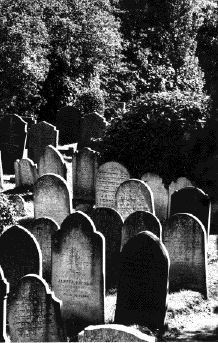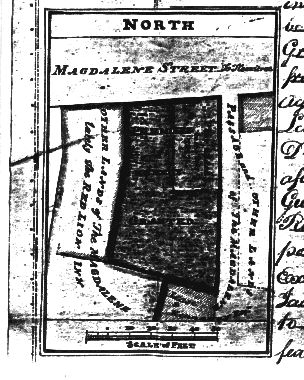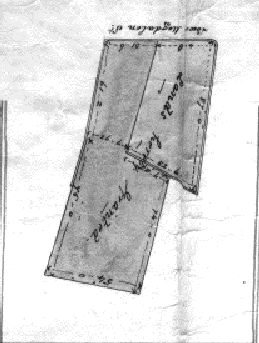|
| ||||
|
|
||||
|
Latest revision or update (including formatting): 15 June 2016 History of the Jews' Burial Ground at Exeter
The Jews' Burial ground in Exeter lies just outside the Roman wall
of the city, near to the South gate, opposite the Wynards Almshouses,
in Magdalen Road. The first lease was taken out in 1757. The nascent
community was following tradition, acquiring a plot of land in which
to bury its dead as a priority before the construction of a
synagogue. The lease is dated 18th May, 1757. The lessors were 'the
brothers and sisters of the house or hospital of lepers of Saint Mary
Magdalen without the South Gate'. The lease was issued to 'Abraham
Ezekiel of the parish of St Kerrian in the city of Exon,
silversmith'. The charge was five shillings, and in return the Jews
received a plot of land 80 feet in length and 22 feet in width. The
lease was for 99 years, and a traditional Devonshire 'lease for three
lives': 'if the said Abraham Ezekiel aged thirty one years, Rose his
daughter aged two years and Israel Henry the son of Henry Israel aged
two years any or either of them shall happen so long to live.' The
annual rent was ten shillings and six pence payable in four
instalments quarterly. In addition, Abraham Ezekiel was required to
build a wall of brick, stone or cob, with coping, eight feet high
around the plot. 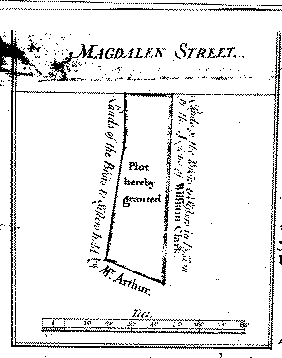
Plan of the burial ground, 1757
This lease was revised and reissued on the 17th January, 1803, in the name of Moses Mordecai, also a silversmith, again for a fee of five shillings, for the plot 'inclosed with a wall and now used by the congregation of Jews as their burial ground'. The three lives were now 'Solomon Ezekiel son of Ezekiel Benjamin Ezekiel of Newton Abbot in the county of Devon silversmith, now aged about seventeen years, Simon Levy son of Emanuel Levy of the city of Exeter silversmith, now aged about twelve year, and Jonas Jonas son of Benjamin Jonas of Plymouth Dock in the said county silversmith now aged about twelve years'. The rent remained the same: ten shillings and sixpence annually in quarterly instalments. On the 23rd June, 1807, Moses Mordecai surrendered the 1803 lease and a new one was issued, adding a 'plot of ground on the east side of and adjoining to the said plot of ground hereinbefore demised containing in length from north to south about forty feet and in breadth from east to west about twenty feet'. The 'lives' remained the same, but the rental was doubled to 'one pound and one shilling'. 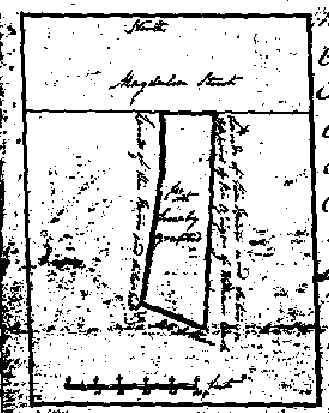
Plan of the burial ground, 1803
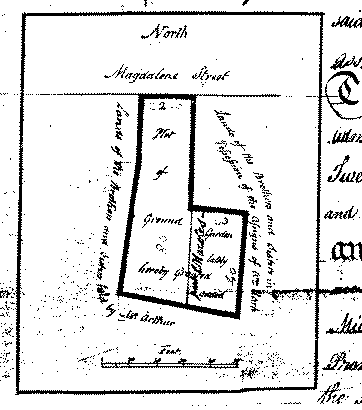
Plan of burial ground, 1807, showing addition of small plot to south east. Plan of burial ground, 1827, showing consolidation of the plot to the north east.
The lease of 24th September, 1827 was issued to 'Henry Ezekiel of the said city of Exeter gentleman, Isaac Solomon of the same city silversmith, Jacob Jacobs of the same city pen manufacturer, Simon Levy of the parish of St Thomas in the county of Devon working silversmith, and Morris Jacobs of the same city silversmith'. The lease of 1807 was surrendered, as once again the congregation desired to enlarge the burial ground 'now in the possession of the Elders of the Jews Congregation of the city of Exeter and contain in length from north to south on the east side eighty nine feet, on the west side seventy five feet, at the south end fifty two feet, at the north end against the said street forty three feet be the said dimensions'. This was a 'squaring off' of the burial ground. The 'lives' were 'Solomon Ezekiel now aged about forty one years and son of Ezekiel Benjamin Ezekiel of Newton Abbot in the county of Devon silversmith, Simon Levy now aged about thirty six years and son of Emanuel Levy of the city of Exeter silversmith, and Jonas Jonas now aged about thirty six years and son of Benjamin Jonas of Plymouth Dock silversmith'. The rent was again increased, to two pounds and two shillings annually. Plan of the burial ground, 1851 showing the big increase in area to more than double its area by the addition of land to the west and south west.
The indenture of 25th May, 1851, was issued to Moses Lazarus of Holloway Street in the city of Exeter jeweller, Joseph marks of Fore Street Hill in the same city clothier, Alexander Alexander of Fore Street in the same city optician, and Emanuel Jacobs of Market Street in the same city stationer'. It granted firstly 'all that piece or plot of ground situate adjoining Magdalen Street in the parish of Holy Trinity in the said city and county of the city of Exeter enclosed within a wall and now and for many years past used by the congregation of the Jews as their burial ground. It also granted a large extension to the west and south west. The lease was for 100 years for the addition, different to the terms for the original plot. The rent was now six pounds and six shillings payable annually in two instalments. Additionally, the congregation paid a large fee of of £150, supplemented by a further £50, which was to be invested to pay any expenses or arrears of rent in the future. This appears to have been an attempt by the community to secure the future of the burial ground at a time when the community was declining in numbers and its future seemed dubious. This was the last lease issued to the congregation, and the leases were completely expired by 1951, but nobody noticed. Nor was the congregation paying any rent, as this was provided for by the investment (though a rent was paid to the city council in respect of buttresses built on Bull Meadow to support the high walls of the burial ground). These technicalities remained forgotten till a bombshell dropped in the ealy 1970s, with the proposal to build an inner bypass for Exeter that would involve the compulsory purchase of the cemetery and the exhumation of all the graves. After a struggle, the burial ground was fortuitously saved by the abandonment of the grandiose scheme, but the congregation had discovered it no longer owned its own burial ground. The matter was resolved by the burial ground being sold outright to the congregation on 18th December, 1977 for a fee of £750, the purchasers on behalf of the congregation being Kurt Wilhelm and Solomon Boam. The Land Certificate also granted ownership of the lane in front of the synagogue to the congregation. A further deed dated 31st May, 1978 made it quite clear that they were acting on behalf of the congregation. The cemetery received extensive repairs in the 1980s during the presidency of Frank Gent, when new gates were fitted, the ohel (chapel) was rebuilt and the walls repaired and rebuilt. During the past three years the cemetery has been maintained by John Richards with the support of Mrs Margaret Quait, with careful maintenance and planting. It is still used occasionally for burials, though the congregation also now has the use of a burial ground provided by Exeter City Council at Exwick. Home | About the Restoration | Holocaust Testimonies | Visit | History | Tour
|



